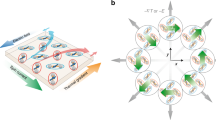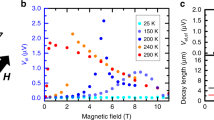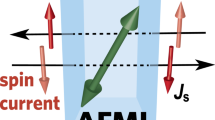Abstract
Spintronics relies on the transport of spins, the intrinsic angular momentum of electrons, as an alternative to the transport of electron charge as in conventional electronics. The long-term goal of spintronics research is to develop spin-based, low-dissipation computing-technology devices. Recently, long-distance transport of a spin current was demonstrated across ferromagnetic insulators1. However, antiferromagnetically ordered materials, the most common class of magnetic materials, have several crucial advantages over ferromagnetic systems for spintronics applications2: antiferromagnets have no net magnetic moment, making them stable and impervious to external fields, and can be operated at terahertz-scale frequencies3. Although the properties of antiferromagnets are desirable for spin transport4,5,6,7, indirect observations of such transport indicate that spin transmission through antiferromagnets is limited to only a few nanometres8,9,10. Here we demonstrate long-distance propagation of spin currents through a single crystal of the antiferromagnetic insulator haematite (α-Fe2O3)11, the most common antiferromagnetic iron oxide, by exploiting the spin Hall effect for spin injection. We control the flow of spin current across a haematite–platinum interface—at which spins accumulate, generating the spin current—by tuning the antiferromagnetic resonance frequency using an external magnetic field12. We find that this simple antiferromagnetic insulator conveys spin information parallel to the antiferromagnetic Néel order over distances of more than tens of micrometres. This mechanism transports spins as efficiently as the most promising complex ferromagnets1. Our results pave the way to electrically tunable, ultrafast, low-power, antiferromagnetic-insulator-based spin-logic devices6,13 that operate without magnetic fields at room temperature.
This is a preview of subscription content, access via your institution
Access options
Access Nature and 54 other Nature Portfolio journals
Get Nature+, our best-value online-access subscription
$29.99 / 30 days
cancel any time
Subscribe to this journal
Receive 51 print issues and online access
$199.00 per year
only $3.90 per issue
Buy this article
- Purchase on Springer Link
- Instant access to full article PDF
Prices may be subject to local taxes which are calculated during checkout




Similar content being viewed by others
Data availability
The data that support the findings of this study are available from the corresponding authors on reasonable request.
References
Cornelissen, L. J., Liu, J., Duine, R. A., Youssef, J. B. & van Wees, B. J. Long-distance transport of magnon spin information in a magnetic insulator at room temperature. Nat. Phys. 11, 1022–1026 (2015).
Wadley, P. et al. Electrical switching of an antiferromagnet. Science 351, 587–590 (2016).
Baierl, S. et al. Terahertz-driven nonlinear spin response of antiferromagnetic nickel oxide. Phys. Rev. Lett. 117, 197201 (2016).
Jungwirth, T., Marti, X., Wadley, P. & Wunderlich, J. Antiferromagnetic spintronics. Nat. Nanotechnol. 11, 231–241 (2016).
Baltz, V. et al. Antiferromagnetic spintronics. Rev. Mod. Phys. 90, 015005 (2018).
Železný, J., Wadley, P., Olejník, K., Hoffmann, A. & Ohno, H. Spin transport and spin torque in antiferromagnetic devices. Nat. Phys. 14, 220–228 (2018).
Jungwirth, T. et al. The multiple directions of antiferromagnetic spintronics. Nat. Phys. 14, 200–203 (2018).
Lin, W., Chen, K., Zhang, S. & Chien, C. L. Enhancement of thermally injected spin current through an antiferromagnetic insulator. Phys. Rev. Lett. 116, 186601 (2016).
Wang, H., Du, C., Hammel, P. C. & Yang, F. Spin transport in antiferromagnetic insulators mediated by magnetic correlations. Phys. Rev. B 91, 220410 (2015).
Hahn, C. et al. Conduction of spin currents through insulating antiferromagnetic oxides. Europhys. Lett. 108, 57005 (2014).
Morin, F. J. Electrical properties of α-Fe2O3 containing titanium. Phys. Rev. 83, 1005–1010 (1951).
Bender, S. A., Skarsvåg, H., Brataas, A. & Duine, R. A. Enhanced spin conductance of a thin-film insulating antiferromagnet. Phys. Rev. Lett. 119, 056804 (2017).
Chumak, A. V., Vasyuchka, V. I., Serga, A. A. & Hillebrands, B. Magnon spintronics. Nat. Phys. 11, 453–461 (2015).
Keffer, F. & Kittel, C. Theory of antiferromagnetic resonance. Phys. Rev. 85, 329–337 (1952).
Rezende, S. M., Rodríguez-Suárez, R. L. & Azevedo, A. Diffusive magnonic spin transport in antiferromagnetic insulators. Phys. Rev. B 93, 054412 (2016).
Wu, S. M. et al. Antiferromagnetic spin Seebeck effect. Phys. Rev. Lett. 116, 097204 (2016).
Seki, S. et al. Thermal generation of spin current in an antiferromagnet. Phys. Rev. Lett. 115, 266601 (2015).
Elliston, P. R. & Troup, G. J. Some antiferromagnetic resonance measurements in α-Fe2O3. J. Phys. C 1, 169–178 (1968).
Yuan, W. et al. Experimental signatures of spin superfluid ground state in canted antiferromagnet Cr2O3 via nonlocal spin transport. Sci. Adv. 4, eaat1098 (2018).
Ganzhorn, K. et al. Temperature dependence of the non-local spin Seebeck effect in YIG/Pt nanostructures. AIP Adv. 7, 085102 (2017).
Shan, J. et al. Criteria for accurate determination of the magnon relaxation length from the nonlocal spin Seebeck effect. Phys. Rev. B 96, 184427 (2017).
Sinova, J., Valenzuela, S. O., Wunderlich, J., Back, C. H. & Jungwirth, T. Spin Hall effects. Rev. Mod. Phys. 87, 1213–1260 (2015).
Zhang, S. S.-L. & Zhang, S. Magnon mediated electric current drag across a ferromagnetic insulator layer. Phys. Rev. Lett. 109, 096603 (2012).
Wright, K. Focus: a trio of magnon transistors. Physics 11, 23 (2018).
Qaiumzadeh, A., Skarsvåg, H., Holmqvist, C. & Brataas, A. Spin superfluidity in biaxial antiferromagnetic insulators. Phys. Rev. Lett. 118, 137201 (2017).
Takei, S., Halperin, B. I., Yacoby, A. & Tserkovnyak, Y. Superfluid spin transport through antiferromagnetic insulators. Phys. Rev. B 90, 094408 (2014).
Stiles, M. D. & McMichael, R. D. Model for exchange bias in polycrystalline ferromagnet-antiferromagnet bilayers. Phys. Rev. B 59, 3722–3733 (1999).
Cramer, J. et al. Spin transport across antiferromagnets induced by the spin Seebeck effect. J. Phys. D 51, 144004 (2018).
Sulymenko, O. R. et al. Terahertz-frequency spin hall auto-oscillator based on a canted antiferromagnet. Phys. Rev. Appl. 8, 064007 (2017).
Kotthaus, J. P. & Jaccarino, V. Antiferromagnetic-resonance linewidths in MnF2. Phys. Rev. Lett. 28, 1649–1652 (1972).
Rezende, S. M. & White, R. M. Multimagnon theory of antiferromagnetic resonance relaxation. Phys. Rev. B 14, 2939–2955 (1976).
Thiery, N. et al. Electrical properties of epitaxial yttrium iron garnet ultrathin films at high temperatures. Phys. Rev. B 97, 064422 (2018).
Moriya, T. Anisotropic superexchange interaction and weak ferromagnetism. Phys. Rev. 120, 91–98 (1960).
Liu, J. Z. Morin transition in hematite doped with iridium ions. J. Magn. Magn. Mater. 54–57, 901–902 (1986).
Ellis, D. S. et al. Magnetic states at the surface of α-Fe2O3 thin films doped with Ti, Zn, or Sn. Phys. Rev. B 96, 094426 (2017).
Besser, P. J., Morrish, A. H. & Searle, C. W. Magnetocrystalline anisotropy of pure and doped hematite. Phys. Rev. 153, 632–640 (1967).
Mitsek, A. I. & Gaidanskii, P. F. The influence of domain structure on the magnetic properties of hematite. Phys. Status Solidi a 4, 319–326 (1971).
Morrison, B. R., Morrish, A. H. & Troup, G. J. High-field antiferromagnetic resonance in α-Fe2O3. Phys. Status Solidi b 56, 183–195 (1973).
Rezende, S. M., Rodríguez-Suárez, R. L. & Azevedo, A. Theory of the spin Seebeck effect in antiferromagnets. Phys. Rev. B 93, 014425 (2016).
Gurevich, A. G. & Melkov, G. A. Magnetization Oscillations and Waves Ch. 3, 69–90 (CRC Press, Boca Raton, 1996).
Jungfleisch, M. B., Zhang, W. & Hoffmann, A. Perspectives of antiferromagnetic spintronics. Phys. Lett. A 382, 865–871 (2018).
Korenev, V. L. et al. Long-range p–d exchange interaction in a ferromagnet–semiconductor hybrid structure. Nat. Phys. 12, 85–91 (2016).
Zhang, S. S.-L. & Zhang, S. Spin convertance at magnetic interfaces. Phys. Rev. B 86, 214424 (2012).
Cornelissen, L. J., Peters, K. J. H., Bauer, G. E. W., Duine, R. A. & van Wees, B. J. Magnon spin transport driven by the magnon chemical potential in a magnetic insulator. Phys. Rev. B 94, 014412 (2016).
Chen, Y.-T. et al. Theory of spin Hall magnetoresistance. Phys. Rev. B 87, 144411 (2013).
Shan, J. et al. Influence of yttrium iron garnet thickness and heater opacity on the nonlocal transport of electrically and thermally excited magnons. Phys. Rev. B 94, 174437 (2016).
Castel, V., Vlietstra, N., Ben Youssef, J. & van Wees, B. J. Platinum thickness dependence of the inverse spin-Hall voltage from spin pumping in a hybrid yttrium iron garnet/platinum system. Appl. Phys. Lett. 101, 132414 (2012).
Jungfleisch, M. B., Lauer, V., Neb, R., Chumak, A. V. & Hillebrands, B. Improvement of the yttrium iron garnet/platinum interface for spin pumping-based applications. Appl. Phys. Lett. 103, 022411 (2013).
Cornelissen, L. J. et al. Nonlocal magnon-polaron transport in yttrium iron garnet. Phys. Rev. B 96, 104441 (2017).
Zhou, X. J. et al. Lateral transport properties of thermally excited magnons in yttrium iron garnet films. Appl. Phys. Lett. 110, 062407 (2017).
Wang, H., Du, C., Hammel, P. C. & Yang, F. Antiferromagnonic spin transport from Y3Fe5O12 into NiO. Phys. Rev. Lett. 113, 097202 (2014).
Upadhyaya, P., Kim, S. K. & Tserkovnyak, Y. Magnetic domain wall floating on a spin superfluid. Phys. Rev. Lett. 118, 097201 (2017).
Acknowledgements
R.L. acknowledges the European Union’s Horizon 2020 research and innovation programme under the Marie Skłodowska-Curie grant agreement FAST number 752195. A.R., J.C. and M.K. acknowledge support from the Graduate School of Excellence Materials Science in Mainz (DFG/GSC 266). All authors from Mainz also acknowledge support from both MaHoJeRo (DAAD Spintronics network, project number 57334897) and SPIN+X (DFG SFB TRR 173). A.Q. and A.B. acknowledge support from the European Research Council via Advanced Grant number 669442 ‘Insulatronics’. S.A.B. and R.A.D. acknowledge support from Stichting voor Fundamenteel Onderzoek der Materie (FOM) and the European Research Council via Consolidator Grant number 725509 ‘SPINBEYOND’. A.Q., R.A.D., M.K. and A.B. were supported by the Research Council of Norway through its Centres of Excellence funding scheme, project number 262633 ‘QuSpin’.
Reviewer information
Nature thanks T. Dietl, L. Morellón and the other anonymous reviewer(s) for their contribution to the peer review of this work.
Author information
Authors and Affiliations
Contributions
R.L. and M.K. proposed and supervised the project. R.L. performed the experiments with A.R. and with technical support from J.C. and L.B. A.R. patterned the samples. R.L., S.A.B. and A.R. analysed the data with input from M.K., A.B. and R.A.D. S.A.B. performed the theoretical calculations with the assistance of A.Q., A.B. and R.A.D. R.L wrote the paper with S.A.B., A.R. and M.K. All authors commented on the manuscript.
Corresponding authors
Ethics declarations
Competing interests
The authors declare no competing interests.
Additional information
Publisher’s note: Springer Nature remains neutral with regard to jurisdictional claims in published maps and institutional affiliations.
Extended data figures and tables
Extended Data Fig. 1 R-plane haematite.
a, Crystallographic structure of haematite α-Fe2O3. The single crystal that we use has an R-plane termination that makes a 33° angle with the easy axis of α-Fe2O3 ([001]). Above Hc, the (111) plane becomes an easy plane. The green and red atoms correspond to iron and oxygen, respectively. b, Temperature dependence of the magnetization in the single crystal of haematite measured by SQUID. The weak ferromagnetic moment is suppressed below the Morin temperature of 260 K. Inset, at 200 K (below the Morin temperature) there is a complete absence of ferromagnetic moment.
Extended Data Fig. 2 Weak ferromagnetic (or canted antiferromagnetic) domains.
Magnetic domains are imaged by MOKE microscopy above the Morin temperature (at 290 K) of an R-cut haematite single crystal.
Extended Data Fig. 3 Magnetic states of haematite under a field.
a, Initial magnetic state of the R-cut haematite single crystal in its easy-axis antiferromagnetic phase at 200 K. The easy axis is oriented about 33° out of plane but only the in-plane projection is relevant. The projection of the easy axis in shown in (x, y, z) coordinates. b, Evolution of the antiferromagnetic state when a field is applied along y. c, Evolution of the antiferromagnetic state when the field is applied along x at (1) small and (2) large fields H.
Extended Data Fig. 4 SMR for a geometry with the wires along x (μ along y).
The black and red circles show data for H along x and y, respectively. The drop in resistance in the H-along-y data at about 6 T corresponds to Hc. The solid lines correspond to a combined regression fit of the H-along-x and H-along-y data of the spin-mixing conductances from equations (4)–(6), yielding \({g}_{{\boldsymbol{n}}}^{(\uparrow \downarrow )}\) = 12.76 nm−2 and \({g}_{{\rm{r}}{\boldsymbol{m}}}^{(\uparrow \downarrow )}\) = 74.82 nm−2. The two field directions are fitted together with \({g}_{{\rm{i}}{\boldsymbol{m}}}^{(\uparrow \downarrow )}=0\), K/J = 0.025 and D/J = 0.011, using λ = 2 nm, θSH = 0.1 and ρ0 = 40 μΩ cm for the normal metal wires.
Extended Data Fig. 5 SMR for a geometry with the wires along y (μ along x).
The red and black circles show data for H along x (perpendicular to the wire) and along y (parallel to the wire), respectively. The jump in resistance around 8–10 T for H parallel to the wire (black) corresponds to the DMI-induced Hc (Methods section ‘Modelling of the Néel order and magnetization orientations’). The jump in resistance at 6 T for H perpendicular to the wire (red) correspond to the more classical Hc. The solid lines correspond to a combined regression fit of the H-along-x and H-along-y data of the spin-mixing conductances from equations (4)–(6), yielding \({g}_{{\boldsymbol{n}}}^{(\uparrow \downarrow )}\) = 31.77 nm−2 and \({g}_{{\rm{r}}{\boldsymbol{m}}}^{(\uparrow \downarrow )}\) = 136.52 nm−2. The two field directions are fitted together with \({g}_{{\rm{i}}{\boldsymbol{m}}}^{(\uparrow \downarrow )}=0\), K/J = 0.025 and D/J = 0.011, using λ = 2 nm, θSH = 0.1 and ρ0 = 40 μΩ cm for the normal metal wires.
Extended Data Fig. 6 Fitting of spin-transport signals.
For the fits we use equation (6) and Sm ≈ S0, with Gm = Sn = 0, K/J = 0.025 and D/J = 0.011. a, b, Platinum wires along x. The fits correspond to Fig. 2. From fitting Rel in a, we obtain a value of G0 ≈ 0.17 mΩ. Here, fitting is done by excluding the largest three points of Rel (dotted lines), where the stochastic transport theory12 is expected to break down owing to strong magnon scattering processes. The main peak around the Hc corresponds to a reduction in the gap Δc of one magnon mode. In fitting b, we extract S0 ≈ 60.6 V A−2 from Rth induced by m. c, d, Platinum wires along y. The fits correspond to Fig. 3c. From fitting Rth in c, we extract S0 ≈ 64.3 V A−2, in agreement with the value from b. From fitting Rel in c, we obtain G0 ≈ 1.42 mΩ (contrary to the value for a). One explanation for this discrepancy could be a different spin-mixing conductance for this orientation, which would be consistent with the spin-mixing conductances extracted from the SMR data (Extended Data Figs. 4, 5). Our theoretical model in d introduces features not observed in the high-field experimental data; hence, we fit the data using G0 ≈ 1.42 mΩ from c. The pale blue dashed line indicates the theoretical features that were not observed in the experiment.
Extended Data Fig. 7 Angular dependence of the non-local voltages for wires along x at different H (below, at and above Hc).
a, Rel has a sin2(α) angular dependence, as expected for a spin signal. b, Rth has an sin(α) angular dependence, as expected for a thermally injected signal. The two signals have maxima shifted by 90°, which shows that Rel corresponds to magnons injected along n whereas Rth corresponds to magnons injected along m.
Extended Data Fig. 8 Distance dependence of Rth for H perpendicular to the wires (along either x or y).
At a field of 10 T, far above Hc, Rth does not depend on the orientation of the wire. Error bars are a combination of the standard error on the mean and the measurement noise floor of the system.
Extended Data Fig. 9 Spin-transport at 4 K and 200 K.
a, b, Platinum wires along x and y, respectively. Rel is shown for H applied along x (the easy axis) at 200 K (filled blue circles) and 4 K (open blue circles). Rth is shown for H applied along y at 200 K (filled black circles) and 4 K (open black circles). The distance between wires is about 200 nm (a) or 500 nm (b), the wire lengths are 80 μm (a) or 160 μm (b) and the applied current is 300 μA (a) or 600 μA (b).
Extended Data Fig. 10 Resistance of the platinum injector as a function of injection current and temperature.
The resistance of platinum is a reliable indicator of the local temperature of the area. An injection current of 600 μA (current density of 2.8 × 1011 A m−2) at 2 K corresponds to the same local temperature as the injector in a helium bath of 25 K with an injection current of 50 μA (current density of 2.3 × 1010 A m−2), signified by the identical resistance values at these two points and hence the same local temperature.
Rights and permissions
About this article
Cite this article
Lebrun, R., Ross, A., Bender, S.A. et al. Tunable long-distance spin transport in a crystalline antiferromagnetic iron oxide. Nature 561, 222–225 (2018). https://doi.org/10.1038/s41586-018-0490-7
Received:
Accepted:
Published:
Issue Date:
DOI: https://doi.org/10.1038/s41586-018-0490-7
Keywords
This article is cited by
-
Electric control of optically-induced magnetization dynamics in a van der Waals ferromagnetic semiconductor
Nature Communications (2024)
-
Transfer of magnetic anisotropy in epitaxial Co/NiO/Fe trilayers
Scientific Reports (2024)
-
Revealing emergent magnetic charge in an antiferromagnet with diamond quantum magnetometry
Nature Materials (2024)
-
Dipolar spin wave packet transport in a van der Waals antiferromagnet
Nature Physics (2024)
-
Chiral mesostructured hematite with temperature-independent magnetism due to spin confinement
Nano Research (2024)
Comments
By submitting a comment you agree to abide by our Terms and Community Guidelines. If you find something abusive or that does not comply with our terms or guidelines please flag it as inappropriate.



